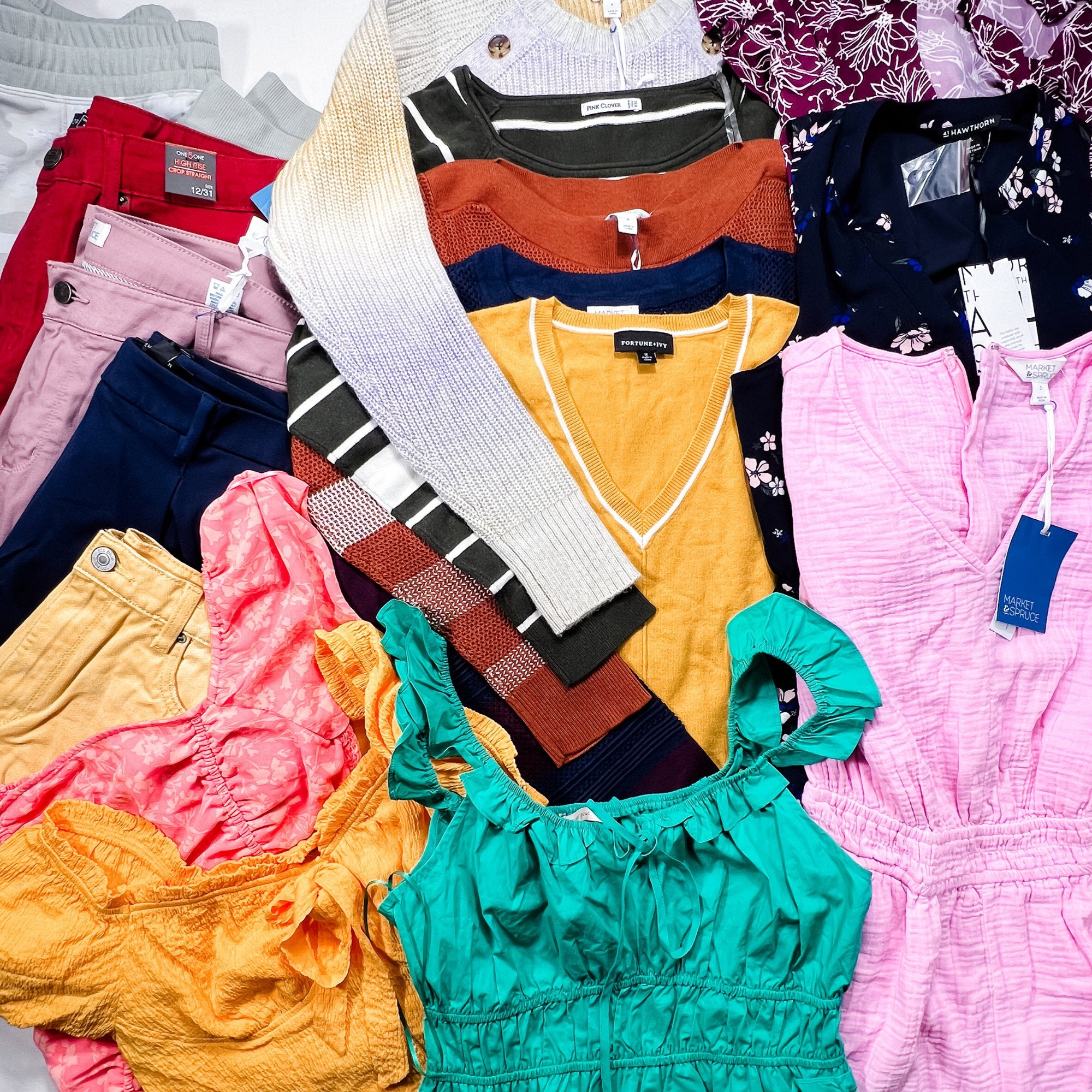The Importance of Sustainable Clothing: Just How It Impacts the Atmosphere and Your Closet
Lasting clothing is significantly recognized for its vital function in minimizing the environmental impact of the rapid fashion business. By concentrating on environmentally friendly materials and moral manufacturing techniques, it addresses pushing environmental worries. This shift not just profits the planet yet additionally affects customer options, resulting in an extra thoughtful method to closet management. Understanding these characteristics elevates necessary concerns about style's future and individual obligation in forming it.
The Ecological Footprint of Rapid Fashion

Advantages of Lasting Products
Sustainable products supply substantial benefits, specifically with eco-friendly fabric choices that minimize ecological injury. These products likewise demonstrate toughness and long life, minimizing the requirement for regular replacements. Consequently, they add to an extra lasting apparel industry and promote responsible customer habits.
Eco-Friendly Fabric Choices
While the apparel industry has long been connected with quick trends and ecological damage, the increase of environmentally friendly textile options offers a transformative chance. Lasting materials such as natural cotton, hemp, and Tencel have gained appeal because of their lower eco-friendly effect. These fabrics are commonly produced without unsafe pesticides and need much less water, decreasing their carbon impact - Branded Clothing. Additionally, several eco-friendly materials are biodegradable, contributing to a round economic situation by minimizing waste. Choosing sustainable products not only supports ecologically accountable methods yet likewise advertises healthier communities. As consumers come to be much more knowledgeable about their acquiring power, the need for environmentally friendly materials motivates brand names to innovate and adopt even more lasting production approaches, inevitably profiting the planet and future generations
Resilience and Long Life Advantages
Many consumers are significantly identifying the sturdiness and durability benefits of lasting materials in their clothes options. Unlike conventional materials, lasting products such as natural cotton, hemp, and recycled polyester are crafted to withstand deterioration, leading to garments that last much longer. This decreased frequency of replacement not only saves consumers money in time but also decreases waste created by fast fashion. On top of that, sustainable clothes commonly uses environment-friendly manufacturing techniques that improve textile toughness, adding to a decrease in the overall carbon impact. By buying long lasting garments, customers can cultivate a much more sustainable wardrobe while taking pleasure in high-grade items that preserve their aesthetic and functionality in time. As a result, sturdiness and longevity stand as essential benefits of picking lasting materials.
Decreasing Waste Via Lasting Practices
Lowering waste in the fashion sector can be attained through innovative methods such as upcycling and repurposing materials. Furthermore, adopting minimal wardrobe strategies urges consumers to focus on high quality over amount, eventually lowering apparel consumption. With each other, these strategies contribute considerably to a more sustainable clothes model.
Upcycling and Repurposing Materials
Upcycling and repurposing products have actually become cutting-edge techniques in the fashion market, changing thrown out fabrics right into important new items. This method not only lessens waste but additionally motivates creativity and uniqueness in garments design. By taking old garments and materials, designers can produce special pieces that reflect individual design while decreasing the need for new resources. Furthermore, upcycling usually needs less power and water compared to standard production procedures, significantly reducing the ecological impact of fashion. As consumers become more knowledgeable about sustainability, the appeal of upcycled garments continues to increase, promoting a circular economic climate. Ultimately, these methods add to a more sustainable future, where style prioritizes ecological health and wellness over fast manufacturing and usage.

Minimal Wardrobe Strategies
As individuals significantly look for to minimize their environmental impact, taking on minimalist closet approaches has actually gained traction as a reliable approach to sustainable fashion. These methods emphasize top quality over amount, encouraging consumers to curate a smaller collection of functional, resilient garments. By concentrating on classic items that can be mixed and matched, individuals can reduce the frequency of purchases and inevitably decrease waste.Additionally, minimalism advertises conscious consumption, advising buyers to assess the honest and ecological effects of their selections. This strategy not just promotes a more lasting lifestyle but also streamlines everyday decision-making concerning outfit. As people accept minimal principles, they add to a style culture that values sustainability and liable consumerism, eventually causing a more eco-conscious culture.
The Function of Ethical Labor in Lasting Fashion
While many customers are significantly conscious of the environmental effects of their clothes choices, the significance of ethical labor techniques in sustainable style can not be neglected. Moral labor encompasses fair earnings, safe working problems, and respect for workers' civil liberties, developing the foundation of responsible style manufacturing. Brands that focus on honest labor not just uplift neighborhoods yet also established a standard for responsibility in the industry.Moreover, the assimilation of honest practices cultivates transparency, allowing customers to make informed options concerning their purchases. This method contrasts sharply with fast fashion's unscrupulous labor versions, which frequently prioritize earnings over individuals. By sustaining firms devoted to ethical labor, consumers add to a system that values human self-respect together with environmental sustainability. Moral labor is not just an add-on; it is crucial to the more comprehensive goal of lasting fashion, guaranteeing that the mission for eco-friendliness does not come at the cost of human rights.
The Impact of Lasting Garments on Carbon Emissions
Sustainable clothes has the potential to greatly lower carbon discharges connected with the garment industry. Typical garment production adds significantly to greenhouse gas discharges, mainly due to energy-intensive manufacturing processes and the usage of non-renewable resources. In contrast, lasting fashion concentrates on green products, such as organic cotton or recycled fibers, which often call for less power to produce.Moreover, lasting brand names have a tendency to embrace much more reliable production practices, minimizing waste and reducing overall exhausts. By prioritizing resilience and classic design, lasting clothes encourages customers to buy much less frequently, additional reducing the carbon footprint connected with overconsumption.Additionally, lots of sustainable brand names are committed to transparency in their supply chains, enabling consumers to make educated options that align with their values. Eventually, moving in the direction of sustainable apparel can bring about a significant decrease in carbon emissions, adding to a much healthier planet and a much more lasting future for the garment industry.
Sustaining Neighborhood Economic Climates With Sustainable Options
The change towards sustainable garments not only addresses environmental issues yet additionally considerably benefits regional economic situations. By choosing sustainable style, consumers commonly support little services and neighborhood artisans, improving neighborhood resilience. These business usually run on a smaller scale, prioritizing craftsmanship and honest techniques over mass production.Investing in locally made lasting apparel cultivates work development and boosts financial development within areas. As consumers come to be much more familiar with the ecological effect of their acquisitions, they significantly look for products that show their values. This demand encourages local manufacturers to take on lasting here methods, adding to a circular economy.Moreover, supporting local companies decreases transportation emissions, straightening with eco-conscious customer habits. The interconnectedness of sustainable clothing and regional economies underscores the crucial function that individual selections play in promoting both financial and ecological wellness. By fostering these local connections, neighborhoods can flourish while additionally functioning towards an extra sustainable future.
Transforming Your Storage Room: Tips for a Sustainable Closet
As people seek to lower their ecological effect, transforming a wardrobe into a lasting wardrobe becomes an important step. One reliable method is to assess existing apparel, keeping just items that are put on on a regular basis and that straighten with sustainability goals. Focusing on quality over amount is vital; buying resilient items from environment-friendly brands can considerably reduce waste.Additionally, integrating used items can rejuvenate a wardrobe while minimizing environmental damages. Organizing clothing swaps with good friends or giving away unused products can better promote sustainability.When buying, individuals must look for materials that are natural, recycled, or eco-friendly, and avoid rapid fashion sellers - Branded Clothing. Exercising mindful usage by attentively thinking about each acquisition can add to a more sustainable way of life. By executing these ideas, one can develop a closet that reflects personal style while sustaining ecological stewardship
Often Asked Concerns
Just How Can I Recognize Lasting Clothes Brands?
To determine sustainable apparel brands, one ought to investigate products used, look for certifications like Fair Trade, and take a look at the brand's openness regarding their manufacturing procedures, labor practices, and ecological influence, guaranteeing moral and environment-friendly methods are prioritized.
What Are the Prices Related To Lasting Style?
The expenses related to sustainable fashion can vary significantly. Higher production expenses, moral sourcing, and green materials frequently lead to raised market prices, which may discourage some consumers while interesting ecologically conscious customers.
Can Lasting Clothing Be Stylish and trendy?
Sustainable clothing can without a doubt be elegant and trendy. Developers progressively prioritize ingenious materials and honest production methods, verifying that fashion and sustainability can exist together. Consumers currently have diverse alternatives that blend visual appeals with ecological consciousness.
Exactly How Does Laundering Garments Affect Their Sustainability?
Washing garments significantly influences sustainability by consuming water and energy, adding to air pollution, and triggering microplastic launch. Regular cleaning can degrade materials, shortening their life expectancy and raising the need for substitutes, inevitably intensifying ecological problems.
What Is the Lifespan of Lasting Apparel Compared to Quick Style?
The lifespan of sustainable garments generally goes beyond that of rapid fashion things, commonly lasting a number of years as a result of quality materials and workmanship. In contrast, quick style garments may break down promptly, necessitating even more constant why not look here replacements. Sustainable garments is significantly recognized for its vital duty in reducing the ecological impact of the quick style sector. While many visit this web-site consumers are progressively conscious of the ecological effects of their clothing choices, the value of ethical labor methods in lasting fashion can not be neglected. Branded Clothing. Lasting garments has the prospective to considerably lower carbon exhausts associated with the style industry. In contrast, sustainable style focuses on environmentally friendly materials, such as organic cotton or recycled fibers, which usually require much less energy to produce.Moreover, lasting brands often tend to adopt much more effective production methods, reducing waste and lowering total exhausts. By focusing on toughness and ageless design, lasting clothing encourages customers to acquire much less often, further decreasing the carbon footprint associated with overconsumption.Additionally, several sustainable brand names are dedicated to transparency in their supply chains, making it possible for consumers to make enlightened options that align with their worths